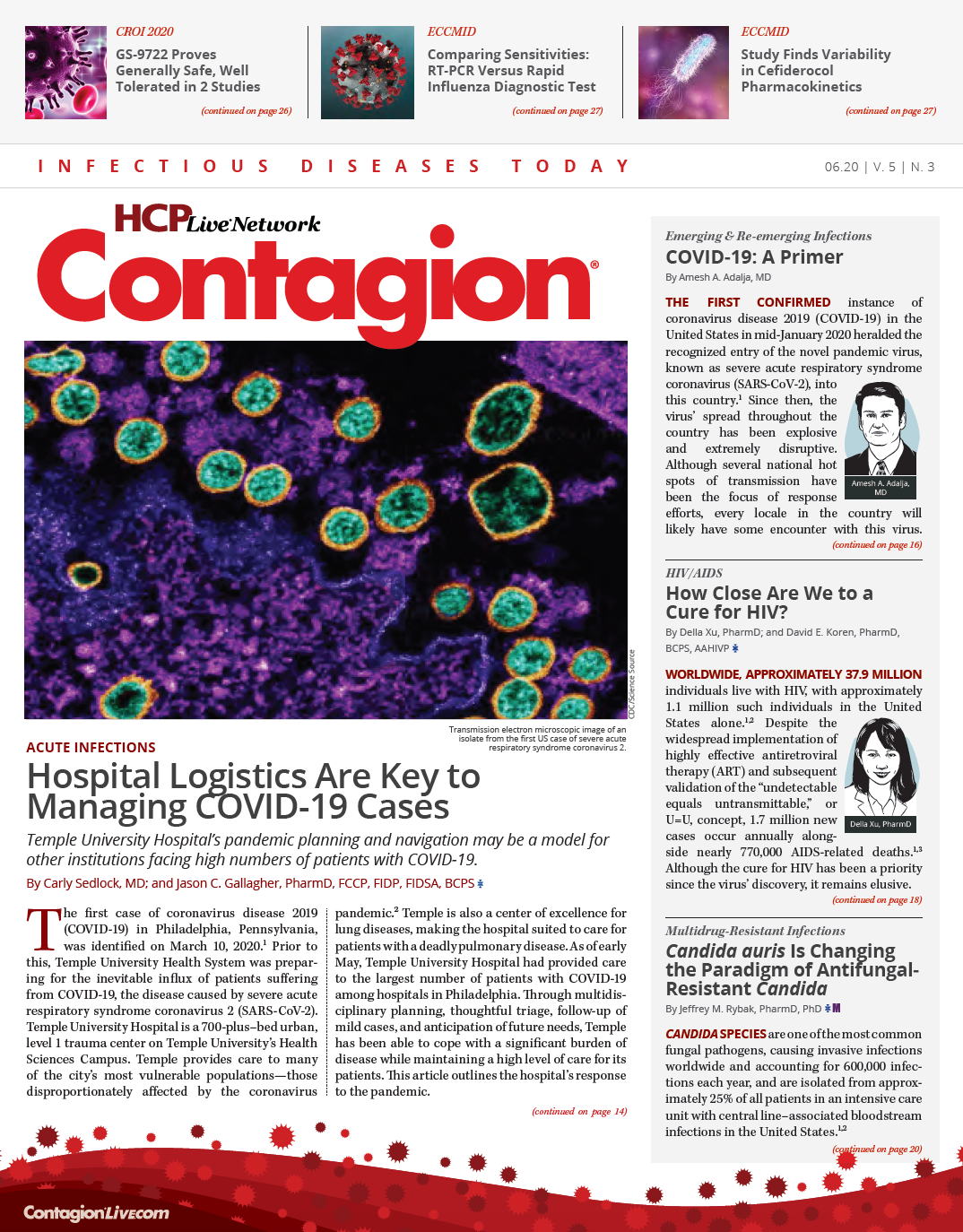Vertical Antimicrobial Stewardship Can Take Programs to New Heights
Expansion of antimicrobial stewardship strategies to include vertical methods represents an opportunity for programs, both new and established, to further optimize antimicrobial use.

Antimicrobial stewards and infection preventionists have worked in harmony for decades. The benefits of this collaboration are evident in several facets, including several models of multidisciplinary efforts to reduce hospital onset of Clostridioides difficile infections (CDIs).1,2 Both new and established antimicrobial steward­ship programs (ASPs) likely have something to gain from careful examination of the design of infection preven­tion strategies. For years, infection preventionists have labored over whether horizontal or vertical strategies are more effective in reducing nosocomial transmission of infectious pathogens. Horizontal methods have histori­cally focused on attempts at reducing broad acquisition of health care—acquired infections through application of practices across wide varieties of patients and settings (eg, hand hygiene, universal precautions, reduction in unnec­essary lines or catheters). Vertical infection prevention methods attempt a more targeted intervention aimed at reducing infections due to a specific pathogen or in a specific patient population (eg, neutropenic precautions, environmental sterilization efforts in C difficile, and active pathogen surveillance with associated isolation).3 When applied to antimicrobial stewardship, horizontal efforts would refer to interventions aimed at reducing or opti­mizing antimicrobial use on a broader scale, whereas vertical efforts would focus on specific drugs and disease states that ref lect key opportunities for improvement.4 A combination of these 2 methodologies, rather than purely vertical or horizontal efforts, will likely produce optimal outcomes.
An institution beginning ASP development will most likely focus on horizontal strategies. This early focus was reflected in the first version of the antimicrobial stew­ardship guidelines from the Infectious Diseases Society of America (IDSA), which placed emphasis on programs implementing the primary strategies of prospective audit with intervention and feedback and formulary restriction.5 Additionally, many of the recommended secondary strate­gies (eg, education, dose optimization, intravenous to oral conversion, and de-escalation) represent horizontal efforts. This early focus on horizontal methods is profoundly important when designing a new ASP, and the efficacy of such strategies in reducing antimicrobial use is well documented.5,6 However, as ASPs gain experience with horizontal methodologies, opportunities for vertical stew­ardship will typically emerge. Nationally recommended strategies have even seen a shift toward incorporation of vertical methodologies into ASP efforts. The 2016 update to the IDSA guidelines for ASP implementation, in addition to stressing the horizontal strategy backbone, places an increasing emphasis on vertical strategies such as patient and/or syndromic interventions, specifically those focused on CDI, β-lactam allergies, bloodstream infections, respi­ratory infections, and febrile neutropenia.6
Vertical ASP efforts focused on CDI reduction have demonstrated significant value. Various intervention types have been proposed and/or evaluated, with the most reliably successful aimed at targeted reductions in antibiotics accompanied by the highest risk for develop­ment of CDI (eg, targeted prospective audit or formu­lary restriction) and CDI-specific provider education.7-9 One recent abstract described a unique, focused effort to reduce antibiotic use in a specific population known to be asymptomatically colonized with C difficile admitted to a single institution.10 In this study, the authors screened patients admitted to 1 of the 5 targeted units over a 7-month period for C difficile colonization using a nucleic acid amplification test collected at the time of admis­sion. An ASP pharmacist then evaluated on a daily basis patients found to be colonized for systemic antimicro­bial optimization and acid suppressive therapy (AST) de-escalation. A total of 265 patients were included, of whom 73% received antimicrobial therapy and 72% received AST. Investigators made antimicrobial and AST interventions in 17% and 26% of cases, respectively. Thirty-seven (14%) patients developed colitis, and of these, 6 (16%) and 10 (27%) had received recommendations for antimicrobial or acid suppressive therapy optimization, respectively.10 The feasibility, potential cost of testing, and lack of control group in this study may limit its overall reproducibility and impact; however, this demonstrates a creative approach to designing a vertical antimicrobial stewardship intervention in patients at risk for CDI.
Another potential application for vertical stewardship methodologies is in patients reporting penicillin allergies. Penicillin allergy is one of the most commonly reported drug allergies, with reported incidences in the popula­tion ranging from 6% to 25%.11 However, results of studies have shown that up to 98% of these patients may have their penicillin allergy delabeled after undergoing skin testing.12 A reported penicillin allergy has known adverse impacts on both clinical and financial outcomes, including longer lengths of hospital stays, increased mortality, higher antimicrobial costs, and increased risk of C difficile, methicillin-sensitive Staphylococcus aureus, and vancomycin-resistant Enterococcus faecium infections.12 The implementa­tion of penicillin allergy testing as an antimicrobial stew­ardship strategy continues to gain momentum given the demonstration of significant impacts on antimicrobial use and outcomes.
One excellent demonstration of a vertical intervention addressing penicillin allergy and associated antimicro­bial prescribing was performed at The University of Texas MD Anderson Cancer Center in Houston.13 This study incorporated both drug- and population-specific vertical considerations as investigators evaluated the impact of penicillin allergy testing on aztreonam use in immu­nocompromised patients with cancer. They performed penicillin skin testing in 49 patients, 46 of whom tested negative. Of the patients who tested negative, 33 were subse­quently switched to a β-lactam antibiotic. This was associated with a significant reduction in overall aztreonam use (10 vs 8 days of therapy per 1000 patient days; P = .005) and a projected savings of $63,192.61.13
Vertical antimicrobial stew­ardship strategies may also be designed to reduce inappropri­ately long durations of therapy in specific clinical syndromes. Interventions focusing on this target may include education, development of local guide­lines emphasizing appropriate durations of therapy, and/or incorporation of a specific clinical syndrome, with a focus on duration of therapy, into a program’s prospective audit. One such study, including 62 patients with commu­nity-acquired pneumonia (CAP), demonstrated significant reduction in duration of therapy for CAP (10 vs 7 days; P <.001) after a 3-tiered intervention comprising a preim­plementation survey of providers, an educational offering, and incorporation of CAP durations into the program’s prospective audit and feedback.14 Another study also demonstrated reductions in antimicrobial use (10 vs 8 days; P = .001) after implementation of both a prospective audit service including patients with CAP and develop­ment/dissemination of a local clinical pathway including recommendations for duration of therapy. Investigators also found a shift from the use of f luoroquinolones to more β-lactam— and macrolide-based regimens, as well as a reduction in inpatient length of stay during the study period (7.24 vs 5.71 days; P = .011).15 These studies demonstrate that a horizontal stewardship method, such as prospective audit with intervention and feedback, can be further tailored into a highly effective vertical method when redirected through a single syndrome.
As the landscape of antimicrobial stewardship, both in the United States and globally, continues to change, programs will need to remain both curious and nimble to innovate and advance practice. Using the existing data within an institution to craft new and creative interventions across the continuum of care is sure to catalyze ongoing program­matic development. The addition of vertical stewardship methods to preexisting horizontal methodologies represents one manner by which a program may further expand and/ or enhance its impact on patient outcomes, antimicrobial use, and health care costs.
Stevens graduated with his doctor of pharmacy in 2010 from the University of Montana and subsequently completed a PGY1 pharmacy practice residency at the Alaska Native Medical Center in Anchorage, Alaska. He is a board-certified infectious diseases pharmacist currently employed at Mayo Clinic in Rochester, Minnesota. *He is an active member of the Society of Infectious Diseases Pharmacists.
References:
- Schultz K, Sickbert-Bennett E, Marx A, et al. Preventable patient harm: a multidisciplinary, bundled approach to reducing Clostridium difficile infections while using glutamate dehydrogenase/toxin immunochromatographic assay/nucleic acid amplification test diagnostic algorithm. J Clin Micro 2018;56(9):e00625-18. doi:10.1128/JCM.00625-18
- Turner MC, Behrens SL, Webster W, et al. Multidisciplinary approach to Clostridium difficile infection in adult surgical patients. J Am Coll Surg. 2019;228(4):570-580. doi:10.1016/j.jamcollsurg.2018.12.045
- Septimus E, Weinstein RA, Perl TM, Goldmann DA, Yokoe DS. Approaches for preventing healthcare-associated infections: go long or go wide? Infect Control Hosp Epidemiol. 2014;35(7):797-801. doi:10.1086/676535
- Patel PK. Applying the horizontal and vertical paradigm to antimicrobial stewardship. Infect Control Hosp Epidemiol. 2017;38(5):532-533. doi:10.1017/ice.2017.44
- Dellit TH, Owens RC, McGowan JE, et al; Infectious Diseases Society of America; Society for Healthcare Epidemiology of America. Infectious Diseases Society of America and the Society of Healthcare Epidemiology of America guidelines for developing an institutional program to enhance antimicrobial stewardship. Clin Infect Dis. 2007;44(2):159-177. doi:10.1086/510393
- Barlam TF, Cosgrove SE, Abbo LM, et al. Implementing an antibiotic stewardship program: guidelines by the Infectious Diseases Society of America and the Society for Healthcare Epidemiology of America. Clin Infect Dis. 2016;62(10):e51-e77. doi:10.1093/cid/ciw118
- Feazel LM, Malhotra A, Perencevich EN, et al. Effect of antibiotic stewardship programmes on Clostridium difficile incidence: a systematic review and meta-analysis. J Antimicrob Chemother. 2014;69(:1748-1754. doi:10.1093/jac/dku046
- Wenzler E, Mulugeta SG, Danziger LH. The antimicrobial stewardship approach to combating Clostridium difficile. Antibiotics (Basel). 2015;4(2):198-215. doi:10.3390/antibiotics4020198
- Dingle KE, Didelot X, Quan TP, et al; Modernising Medical Microbiology Informatics Group. Effects of control interventions on Clostridium difficile infection in England: an observational study. Lancet Infect Dis. 2017;14(4):411-421. doi:10.1016/S1473-3099(16)30514-X
- Revolinski S, Tran C, Huang A, Wainaina N, Munoz-Price S. Implementation of a vertical antimicrobial stewardship intervention for patients colonized with Clostridium difficile. Open Forum Inf Dis. 2018;5(suppl 1):S102. doi:10.1093/ofid/ofy210.250
- Castells M, Khan DA, Phillips EJ. Penicillin allergy. N Engl J Med. 2019;381(24):2338-2351. doi:10.1056/NEJMra1807761
- Sakoulas G, Geriak M, Nizet V. Is a reported penicillin allergy sufficient grounds to forgo the multidimensional antimicrobial benefits of β-lactam antibiotics? Clin Infect Dis. 2019;68(1):157-164. doi:10.1093/cid/ciy557
- Foolad F, Berlin S, White C, et al. The impact of penicillin skin testing on aztreonam stewardship and cost savings in immunocompromised cancer patients. Open Forum Infect Dis. 2019;6(10):ofz371. doi:10.1093/ofid/ofz371
- Avdic E, Cushinotto LA, Hughes AH, et al. Impact of an antimicrobial stewardship intervention on shortening the duration of therapy for community-acquired pneumonia. Clin Infect Dis. 2012;54(11):1581-1587. doi:10.1093/cid/cis242
- Gordon K, Stevens RW, Westley B, Bulkow L. Impact of an antimicrobial stewardship program on outcomes in patients with community-acquired pneumonia admitted to a tertiary community hospital. Am J Health Syst Pharm. 2018;75(11)(suppl 2):S42-S50. doi:10.2146/ajhp170360



















